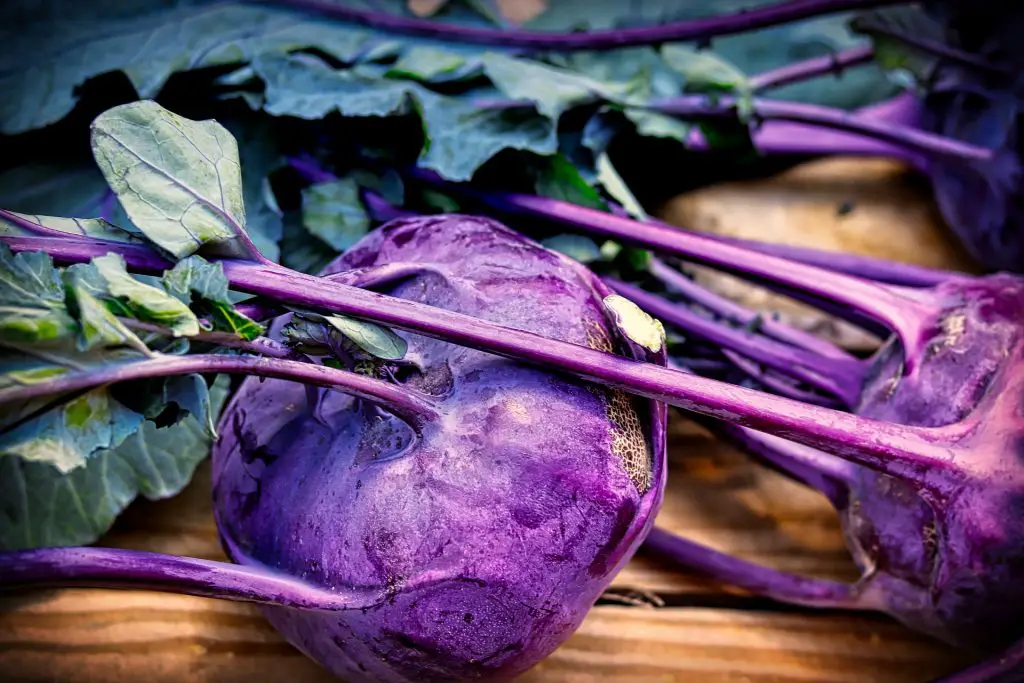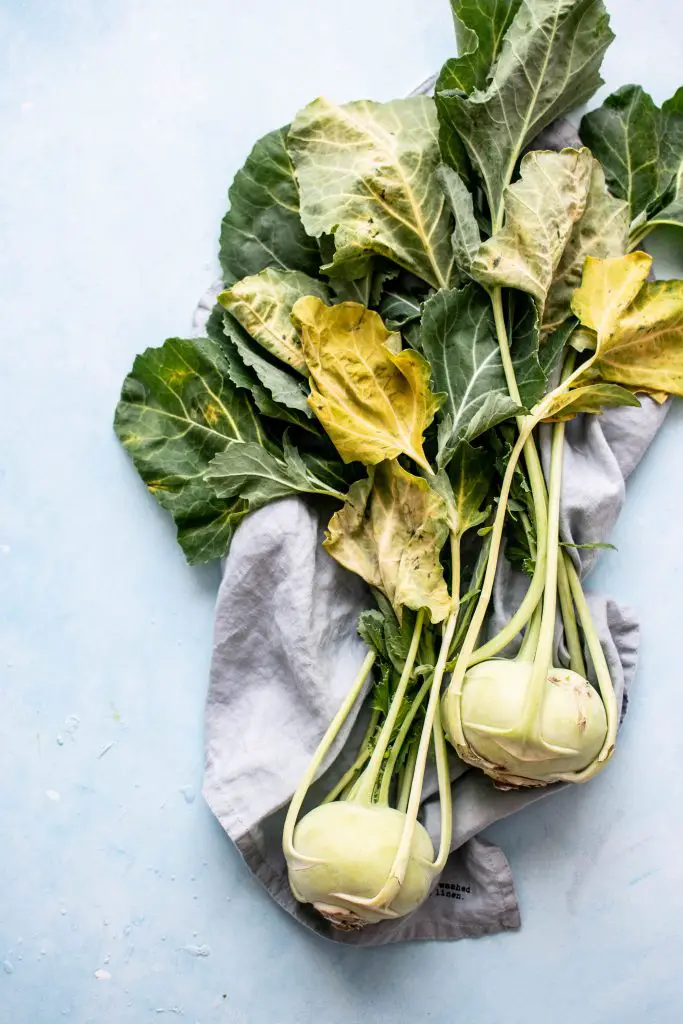How Big Does Kohlrabi Grow? Kohlrabi is a popular vegetable in German-speaking countries and those areas that have a strong German heritage such as Minnesota. However, for many people in English-speaking countries, Kohlrabi is a vegetable that does not appear commonly in gardens or markets. If you are considering growing a plant in your vegetable patch the obvious question how big does a Kohlrabi get and how much can you yield from a plant?
The size of a Kohlrabi can vary widely depending up the time of year it is planted, however, in most cases, the weight of a stem will reach 7 to 25 oz (200 to 700 gms) according to a study by the University of Trakya. The size is largely dependent on how long the stem is given to grow in favorable conditions, the longer the time the larger the stem.
However, the usefulness of the stem produced can be affected by the timing of planting. Kohlrabi plants tend to flower in spring and the production of flowers can often result in the stem becoming woody and tough to eat. This means that the production of tender stems in spring plants requires the plant to be harvested when the size of the stem is a little larger than a golf ball.
If the Kohlrabi is planted after the flowering period in late spring or early summer a much larger but viable stem can be produced. Below is an excellent video by Charles Dowding, a market gardener with 30 years of experience, on Kohlrabi that is well worth watching.
In What Conditions Does Kohlrabi Grow?
Kohlrabi is a member brassica family which includes Broccoli, Cauliflower, and Kale. All the plants within this family, including Kohlrabi, are hardy plants that can tolerate frost and Kohlrabi will survive at temperatures as low as 15°F (-9°C).
However, to grow Kohlrabi requires daytime temperatures that exceed 40°F (4°C) but higher temperatures up to 75°F (24°C) are preferred. This makes sowing in early spring and mid to late summer the preferred sowing times.
Sowing a winter vegetable in summer may seem counter-intuitive however to be able to pick a crop of Kohlrabi in late Autumn or Winter it is essential that the plant has an opportunity to develop in size in warmer weather before it begins to cool down. Then the developed vegetable can then sit in the garden ready to pick throughout the winter. To find out more about how to time the sowing of seeds for winter vegetables click here.
How To Optimise The Yield Of Kohlrabi?
As discussed earlier in the article the size of the Kohlrabi is largely dictated by the length of time that the plant is exposed to favorable conditions. To optimize the size of the Kohlrabi crop in Spring plantings it is important to sow the seedlings as early as possible in the season.
To extend the growing time of the Kohlrabi it is advisable to sow the seed undercover indoors in mid to late winter. For best results, it is best to use a heated propagation tray rather than solely rely upon heat sources in the house which can result in significant temperature fluctuations at different times of the day.
The product that we recommend for this purpose is the iPower Heating Seed Starter Germination Kit which is shown in the picture below. It is relatively low cost and features a vented dome which helps to maintain humid conditions. Click on the link to see the current price on Amazon.

The seedlings in a heated propagating tray will take between 4 to 6 weeks to reach a reasonable size before they can be planted out into the garden. To improve the conditions for the seedlings once they are planted in the garden it is advisable to use a cloche or a row cover.
According to the Royal Society of Horticulture, the use of a cloche or a row cover can increase the soil temperature by 10°C (18°F) which will increase the speed of growth in the early part of the season and therefore the size of the stem that can be harvested.
If you don’t currently own a row cover the one we would recommend is the Growsun Garden Tunnel Plant Cover because it is relatively tall and has hoops that can be anchored deeply into the ground which allows it to resist wind. The product is shown in the image below.

When planting in Summer or Autumn the key determining factor of the size of the harvest is the timing of the planting. It is recommended that seeds be planted around the 15th to 30th June along with other winter crops. Planting at this stage rather than in winter will often result in a Kohlrabi that is almost double the size of the Spring crop.
The exception to this is in warm climates where the summer temperatures are extreme and the winters are relatively mild. These conditions necessitate a later planting of Kohlrabi, however, in these climates, zone 10 or 11, because of the mild winters it is still possible to get a decent-sized stem.
How To Grow Kohlrabi
Kohlrabi is a hardy frost-tolerant vegetable that is best grown in Spring or Autumn for the most part. It is capable of being stored in the garden throughout the winter provided that the winters are not too cold.
As Kohlrabi is not an overly popular vegetable the availability of seedlings is not all that common at garden centers. This means that most gardeners wanting to grow Kohlrabi will need to grow it from seed.
If you live in the US Kohlrabi seeds are available from companies such as Seeds for Generations or St Clare Seeds and in the UK try Thompson & Morgan. Kohlrabi is available in green-skinned and purple-skinned varieties, with Purple Vienna being one of the most common. Irrespective of the color of the skin the central flesh will be white.

When planting in Spring it is best to sow Kohlrabi 4 to 6 weeks before the last average frost date in Spring and from mid-summer onwards. Kohlrabi will mature in 80 to 120 days from the date of sowing however, this can vary substantially depending upon the time of year.
When sowing the plants into modular trays it is best to sow 2 to 3 seeds per cell to ensure that all cells are occupied with at least one plant. Any additional seeds can be thinned at a later stage.
The seedlings will typically take between 4 and 6 weeks to reach a sufficiently large size which allows them to be planted outside. When planting them out they should be spaced 12 to 16 inches (30cm to 40cm) apart.
In terms of soil conditions, Kohlrabi prefers moist, well-drained soil that contains plenty of organic matter and is slightly acidic, a pH around 6.5 is ideal.
To measure the pH of soil it is best to use a pH meter rather than a pH kit with strips because it is easier to use and cheaper, to check the latest price on Amazon click here.
If the pH of the soil is outside the desired range it can be adjusted by adding lime to raise the pH or sulfur to lower the pH. Any additions to the soil should be thoroughly mixed into the soil before planting. To learn more about why pH is important click here.
Once the soil has been prepared and the seedlings have been planted it is important to mulch around the plants and ensures that they are well watered in. In warmer conditions throughout the season, it is also important to continually water the plants, particularly in Spring as dry conditions can stress the plant causing premature flowering.
The Kohlrabi is normally harvested by removing the whole plant once the stem has reached an acceptable size. At this point, the roots, and leaves of the plant should be removed immediately, as this will help with storage.

How to Store Kohlrabi
Produce from the Summer/Autumn sowing stores far better than stems produced from the Spring sowings. The main reason for this is largely because in most cases the Kohlrabi is much larger and the conditions in places of storage are generally more favorable.
Additionally, if you live in a region that does not get too cold in winter the Kohlrabi can simply sit in the garden until you are ready to use it. However, if it is necessary to pick the stem it can be stored successfully for several months.
Kohlrabi can be stored for at least 3 months in Winter, provided it is kept in a dark, dry, and cool area, less than 40°F (4°C) is ideal. When storing the vegetable the leaves and stem need to be removed as they will degrade quickly. Apart from this, there are no other special conditions required, the Kohlrabi will remain in reasonable condition if stored in a cardboard box.
